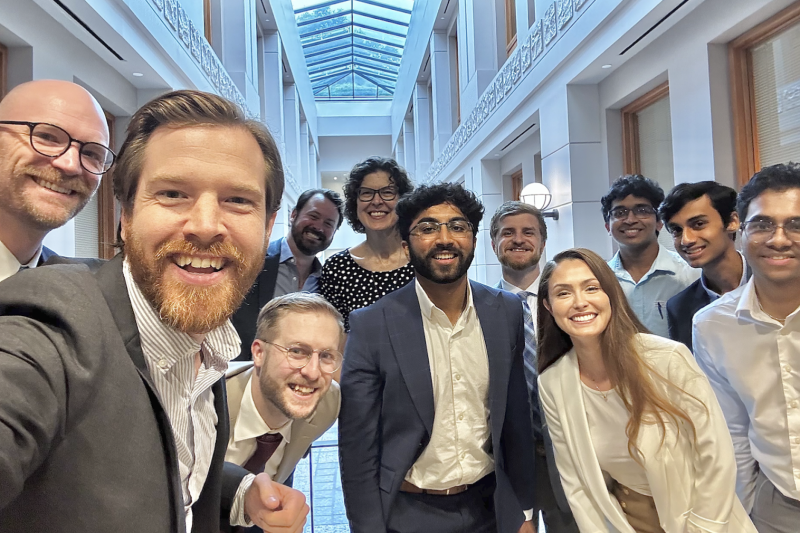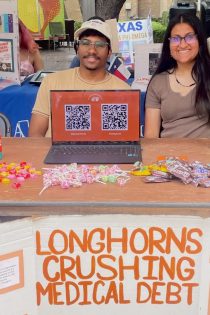UT Students Help to ‘Crush’ $1.5 Million in Medical Debt
By Rachel N. Madison
Reporting Texas

Dollar For executive Jared Walker, left, takes a selfie with Let’s Crush Medical Debt members and other allies at the Texas Capitol where they sought the Legislature’s help in requiring hospitals to tell patients about charity care options. Photo courtesy of Jared Walker
In 2020, Austin resident Zachary Cook was run over by a car while walking down a sidewalk. After several weeks in a hospital for severe injuries, he returned home to find a $78,000 medical bill in the mail.
Unable to pay, Cook searched for assistance online and found Dollar For, a national nonprofit that helps patients navigate medical debt and health care expense reduction programs.
With Dollar For’s assistance, Cook was able to waive his bill through Ascension Seton Hospital’s charity care program.
“There was nothing stated in the hospital to me about charity care,” Cook told Texas lawmakers last spring. “I was just very lucky that I found an organization that could help me out.”

Let’s Crush Medical Debt members Guhan Periyasamy, left, and Maheen Shujaat promote their group at UT student orientation this year. The organization, founded in 2022, now has over 70 members and spreads awareness of debt forgiveness programs to communities in need. Photo courtesy of Let’s Crush Medical Debt
Cook’s story is one of many that inspired UT students to form Let’s Crush Medical Debt, an Austin chapter of Dollar For. The group works to spread awareness of federal medical bill forgiveness programs like charity care.
“Nothing is more valuable than going into the field and hearing people’s stories firsthand,” said the group’s co-president, Swati Misra.
Over 100 million Americans, or 41% of the population, face some form of health care debt, according to a KFF Health News study. It is the leading cause of bankruptcy in the country.
“The scale is huge,” said Noam Levey, a KFF reporter who led the investigation.
Of those who have health care debt, one-quarter have more than $5,000 in debt and one in eight Americans have more than $10,000 in medical debt, he said. The study found that young people, Black Americans, lower-income groups and people with chronic illness are all more likely to end up in medical debt.
“It’s something that haunts people for years and years,” he said, often forcing them to cut back on essentials like food, clothing and living costs.
Nonprofit Texas hospitals are required by law to offer a certain amount in charity care relief to qualifying patients as a public benefit to maintain their tax exempt status. If a patients’ income falls below twice the federal poverty line, they may be eligible for the program.
Dollar For, based in Washington state, helps patients screen for bill reduction eligibility, complete applications and manage patient-hospital communications for patients across the country. So far, the organization says it has eliminated over $100 million in medical debt nationwide and hopes to surpass $1 billion by 2028.
While the charity care program exists on paper, hospitals often fail to notify patients of eligibility before their bills are sent to collections, said Jared Walker, executive director of Dollar For.
“Most patients leave the hospital without any knowledge of these programs,” he said at a April hearing for a Texas bill that would’ve required hospitals to automatically screen patients for charity care eligibility. “It is not enough to have policies on paper. Patients need real access and real help.”
“We get more requests for help from Texas patients than any other state in the country,” said Eli Rushbanks, the group’s general counsel. “From our position, Texas hospitals are just not keeping up their end of the social contract.”
While the bill didn’t pass, Let’s Crush Medical Debt members argue that the hearing demonstrated the importance of public awareness of these programs for Texas patients.
The student members were among the 17 who testified in support of the bill.
Founded by two students in 2022, Let’s Crush Medical Debt now has over 70 members and is led by a team of 11 undergraduate officers with majors ranging from biomedical engineering to business, member Guhan Periyasamy said.
The organization offers weekly volunteer opportunities for members across their over 45 active Austin partnerships, which include CommUnity Care, RAISE Texas, Micah 6 and the Sunrise Homeless Navigation Center, where they distribute informational flyers and resources to in-need communities to spread awareness of debt forgiveness programs.
“Going through the debt relief process isn’t new, but it is foreign to navigate for someone without all of the information,” said member Vaishu Marreddy.
The organization also helps non-English speaking patients access dual-language versions of forms to assist in filling out complex applications.
This year, Let’s Crush Medical Debt says it helped cut $1.5 million in medical debt for Austin-area patients through their advocacy efforts.
Let’s Crush Medical Debt member and communications director Neha Garlapati said that the financial burden of medical debt isn’t a choice.
“Your ZIP code determines your health more than your genetic code,” she said during a tabling event at Micah 6, a food pantry at University Baptist Church in Austin, in early October.
“Debt is more than a statistic. It’s deeply personal and cultural,” said Marreddy, who said she’s found personal meaning in her involvement with the group.
While patient advocacy programs are just one tier of medical debt interventions, they are essential in “helping patients navigate the system, raising awareness about problems in charity care and pushing for more systemic steps and policies and laws that could improve this so that more people can access the aid to which they are entitled,” Levey said
However, these efforts only treat what Levey described as “symptoms of the problem.” Having good health insurance is the most fundamental measure to prevent people from going into medical debt, and it is currently under threat, Levey said.
Trump administration funding cuts to Medicaid and health insurance earlier this year have limited patient access to care and enforced barriers to minority and non-English-speaking individuals.
U.S. medical debt is expected to rise in the coming year if current Affordable Care Act premium tax credit subsidies are not renewed by Congress.
“Many will drop insurance all together,” Levey said, pushing “more people into medical debt.”
Let’s Crush Medical Debt leaders say the group will continue to advocate for bills that increase health care transparency and patient support in the next legislative session, which begins in January 2027.
“Our boots will be on the ground,” said Rishit Yokananth. “We’ll be ready.”